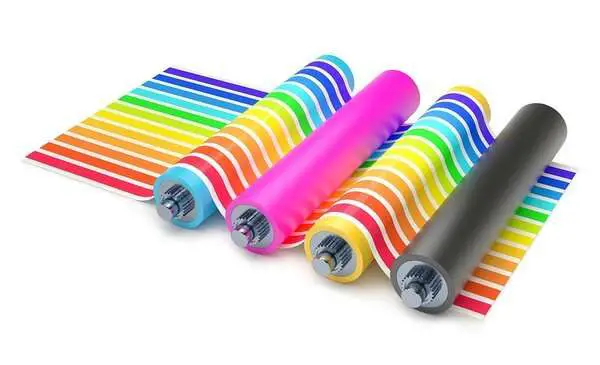Dye-sublimation printing can be fun for DIY projects, but it can be a pretty tough business. Dealing with those ever-so-pushy clients can be pretty frustrating.
But the business can be pretty rewarding, and you can follow different routes to make your business run smoothly. The way is having the best supplies, especially that sublimation paper you use.
But how do you choose the right sublimation paper to use? What are its different types, and what purpose does each of them serve?
We will discuss everything you need to know about dye-sublimation papers in this guide.
Criteria to Decide What Sublimation to Choose?
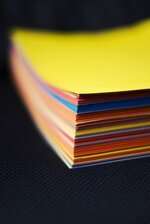
Sublimation papers are critical to the entire sublimation process. So, if you don’t have the right kind of sublimation paper with you, then those transfers will be subpar, and you know you don’t want that to happen.
But focusing on too much quality will increase the price, and that will exceed your budget. Some rare papers that ensure exceptional quality is pretty hard to come. So, you need to balance it all out to make it work for you.
Paper size and weight are the standard and apparent metrics to assess the quality of the sublimation paper. But what exactly do they mean?
Paper size

There should be no ambiguity here as size refers to how big a paper sheet you are using is. The sublimation paper you are using must fit the scope of transfers and designs.
You also have to double-check that your printer can handle the size of your paper.
The standard is A4 size, which measures 8.5×11 inches, but it will not be handy if you work with larger transfers onto sweatshirts or t-shirts.
Super B (13×19 inches) might be a bit of overkill if you are going for some transfers for hats or socks. So, you need to pick the right size that fits your designs and design transfers along with your printer. This way, you won’t end up wasting your money on useless paper.
Paperweight
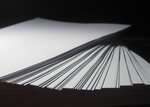
Weight can be a pretty confusing characteristic to measure the quality of the paper. But it’s not that complicated to understand the concept here. This paperweight refers to two essential things. One is the ream’s weight of the paper.
Now, what’s this ream thing?
A ream of your standard paper for printing weighs 20 lbs. And a ream here refers to 500 sheets. Now, if you pick up this ream, you will notice that it doesn’t weigh 20 lbs, and this is where things get confusing.
There is a much simpler and more standard way of measuring paperweight as confusing as it can get. This method is called the GSM technique. GSM refers to grams per square meter.
This measurement expresses the overall density of the paper. Most types of writing are expressed in GSM, so things get much easier to compare between different papers.
- Other critical factors
- Ink limits and capacities
With a higher ink limit or wetness, a heavier paper should take the moisture in with no hiccups such as warping and curling.
Ink pattern
You can work on light and heavy designs with your ink. Unfortunately, low-weight papers will not work very well here because they end up shifting or curling right after processing.
Therefore, you need to work with at least 110 GSM paper or more to handle high and low ink patterns and designs.
Roll-to-sheet & roll-to-roll

Heat presses for calendars need to work with low-GSM papers. But when you are using heavy ink, then you will have to choose capacity and limit wisely. You might end up dealing with curling, warping when you are going for high-capacity production.
Print speed
You also need to consider the print speed. If you are looking to go for faster prints, you must use thinner paper and when you are going for slower prints, choose thicker paper.
Does Humidity Affect the Quality and Performance of Sublimation?
In low humidity under 45 percent, the best option you need to consider when it comes to paperweight is 80 GSM. in low humidity, paper shrinks, and the print side is hunched up. In this process, when the paper receives the ink, you will have to deal with hunching up.
100 and 120 GSM paper is harder than 80 GSM, so that any hunching will damage the print side. On the other hand, 80 GSM is softer paper and will handle hunching, and it will also keep your print head safe.
With high humidity that is over 70 percent, you need to go for 110 to 120 GSM paper. At high humidity, sublimation paper will get damp and lose its stiffness and softness.
If you use low-weight paper, any smooth prints will not come out, and hardness will decrease. Therefore, you need to consider only harder or thicker paper to tackle high humidity at your workplace.
What are the Different Uses of Sublimation Paper?
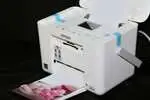
You can use sublimation paper for a variety of transfers and designs on a range of different materials. For example, you can use sublimation paper on lycra materials, polyamide, cycling wear, surf, and swimwear when looking to use apparel. Likewise, stretch polyester, ice hockey wear, running wear, and functional and sports textiles.
When talking about home usage, you can use sublimation paper for blinds, curtains, table covers, cushions, towel cleaners, and so much more. In addition, you can use sublimation paper for advertisement for banners, flags, gaming tablets, felts, and home textiles.
You can use this paper for your sublimation transfer and orient mirror reversal using your sublimation printer. You can also use an inkjet printer, screen printer, gravure printer, or flat printer.
Transferring of the design occurs with pressure and heat. With this heat and pressure, ink is converted into gas, and it combines with the media on which you are trying to transfer the design.
Four Different Types of Heat Press
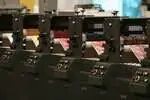
When discussing the size and weight of sublimation paper, you also need to consider the types of heat press you can use. Small is not going to be a big deal, but if your paper is more significant than the heat press, the design will not transfer well.
So, there are four different heat types that you can choose for:
- Calendar heat press
Cleander heat presses and more prominent in size, and they are built to transfer larger designs. They are great for flags, larger banners, soft signage as well as fabric sublimation.
- Small format heat press
This type of heat press is a top choice for you to sublimate on small items and t-shirts. You can go for mugs, caps, shoes, plates, and t-shirts.
- Flatbed heat press
They will not be more effective in managing different fabric sizes and rolls than calendar heat presses, but they are pretty versatile. It means you can use them to transfer your designs on floor mats, hardboard, aluminum, and various unique media.
- Heat Press 3D Vacuum
This compact-sized desktop machine generates heat transfer onto different materials with curved shapes or edges. You can use sublimation blanks along with pre-treated objects like mugs, phone covers, sporting goods, picture frames, and buttons.
Best Sublimation Paper
A-SUB
This paper is a preferred choice for most because they have different paperweights available. But what makes them the best is that their sublimation paper is the thickest out there. It ranges from 120 GSM to 130 GSM.
Thicker paper is a much better option if you want to get good quality for your design transfers. This happens because the thicker paper is less likely to crease when transfers are taking place. In addition, this paper is a lot better when it comes to handling stress as well.
It can also hold the sublimation ink, and it can also allow high fidelity and high-quality transfer. Additionally, they also have a wide range of designs available.
You can work with smaller designs as well as larger transfers. You can always find the right size when you are going for an A-SUB sublimation paper.
Another significant advantage of using A-SUB paper is that it is available quite easily. You can buy it online and can shop for fit from your local printing stores as well. It means that A-SUB checks all the boxes when it comes to quality, weight, size, and availability.
But there’s a catch as well, and that’s its price. You are getting the best quality here and have to pay for it. However, it will be worth every penny if you have the right budget for it.
The paper is going to cost you around $20 for its 125 GSM sublimation paper. This is something on the higher side. But if you can afford it, the quality and consistency it can provide in your transfers will make you pay for it with a smile.
Koala
If you can’t find A-SUB accessible for some reason, you can go for the Koala sublimation paper. You will find a wide range of paper sizes available here with this brand, and you will also find different paperweights.
The selection available at A-SUB is still much bigger, but Koala also has rough options available for you to complete various projects. You can go as small as 4×9 and as large as 13×19 here with the Koala.
This paper is also a bit on the thicker side, and you will find their sublimation papers ranging from 120 GSM to 130 GSM. So, you won’t have to deal with any creases in your transfer. This range of weight is a top choice for dealing with a variety of DIY sublimation projects.
Koala is also readily available, but they don’t handle paper volumes as A-SUB do. But you won’t have any trouble when ordering the Koala paper as well.
The best thing about this paper is that it is much cheaper than A-SUB too. For example, 110 sheets of Koala will cost you about $20,1, which is much less than A-SUB. So now, if it’s so great and its price is lesser than A-SUB, then why is it a number 2 spot?
That is because Koala doesn’t handle that much order volume, and its quality is slightly lower than A-SUB. Plus, the design quality that you will get on koalas is lower than A-SUB as well. So the most significant benefit here is the price while its quality is at par.
DyeMaster
This is a good option for a sublimation paper, and it comes with a success rate of over 98%. So, if you are working on a variety of projects simultaneously and can’t seem to find the right option for your transfer, DyeMaster is going to be a great option.
This paper suits well for mugs as well as other things. As you are going to use it for numerous purposes, it’s a pretty versatile option. You will only have to make sure you print the mirror printing button on that white side.
And then set the temperature and the time according to the requirement mentioned for the heat press and the paper. You will get extraordinary colors on this paper, and it can handle those high-definition images too.
This paper is all about high-quality color reproduction and quick drying. You won’t have to deal with soft sections or cracks, and the transfer rate is pretty high as well. There won’t be any fades, and the designs will be long-lasting as well.
Seagol
This sublimation paper is a great option if you have to deal with colored garments. It can conveniently handle polyester, cotton as well as polyester-cotton blends.
This paper comes pre-cut and is entirely ready to take ink from your printer. Therefore, you can place it straight away on your printer, and you can enjoy those extraordinary results in no time at all.
As a new startup or an individual just starting with sublimation printing, you will be looking for a slightly budget-friendly option. Using Seagol papers for sublimation can help you achieve your desired printing cost.
This paper is all about vibrant colors. You might see some design laps in minor details. Since it’s thin paper, it is prone to crease. Therefore, you will have to be a lot more careful in handling it.
Nevertheless, the colors you will get here will be authentic and stick on most surfaces. This paper is compatible with colored garments as well, and it comes pre-cut so you can load it in your printer right out of the box.
Printers Jack
Another option here is the Printers Jack sublimation paper. But if you are only looking to get the job done and are not after exceptional quality, then this sublimation paper is a good option.
This is only a good option if you are looking to try something new other than A-SUB or Koala or if you can’t get a hold of these two brands in your area. Otherwise, the other two options are much better.
The awkward thing about this brand is that they don’t advertise and display any paperweight on their listings either. The paper they have is much thinner and flimsier, so chances of creasing are much higher with Printers Jack.
Moreover, they don’t have much variety when we talk about volume and sizing as well. So paper wastage is a thing that you will have to deal with here as well. But they come with an even lower price tag if you compare them with koalas.
Their 100 8.3×11.7 sheets are going to cost you around $16. This price is a bit cheaper than koalas, but the cost difference will appear to be only marginal when you deal with wastage.
This brand is readily available too. But it is only a recommended option if you are looking to try some new out or just testing out different designs for practice. It will also work for you if you are starting with sublimation.
Some Important Guidelines When Transferring for Your DIY Sublimation Projects
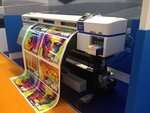
You need to remember some essential things when transferring your design to different materials for your sublimation DIY projects.
First, you have to use the right temperature and time to transfer your design to different materials.
For example, when dealing with polyester apparel, you have to keep the heat press at 390F to 400F and press it for 35 seconds. On the other hand, when working on SubliSocks the temperature should be 370F, and you need to keep it pressed for 30 seconds.
If you are working on cell phone covers, the temperature should be 400F and 45 seconds. With those polymer-coated plastics again, the temperature would be 400F, and the time would be 75 seconds.
Metals will need 400F and 60 seconds, while the wood will need the same temperature, but the time will be 75 seconds. The temperature for ceramic tiles is 400F, but the time here is the most, and the transfer will need 4 minutes.
Not all sublimation blanks and paper are the same. You will have to go for a different combination of temperature and time with each type. But if you are not sure, then check the instructions with which the paper comes before you start working on your DIY project.
Look for the instructions mentioned for the heat press. You can also use the contact thermometer for this purpose to make sure that you are using the right combination of temperature and timing.
FAQs
What paper type is sublimation paper?
This is a special paper made with a substrate that you can exclusively use for sublimation printing. But it does come with a coating added to the top of the paper’s surface to hold the sublimation inks in.
What is the difference between sublimation paperweights?
Lightweight paper is a better choice when you need light saturation. Heavier sublimation paper is a good option if you are going for heavy saturation. This is because, with heavy or high saturation, your colors will come out brighter and more vivid. Light paper is used when you need lighter or dimmer colors.
Which side of sublimation paper do I print on?
If you are new to sublimation printing, you might find it difficult to choose which side of the sublimation paper to print on. You need to keep in mind that you have to use that bright white side of the sublimation paper for printing. This is the side where the print is going to come out on.
Is a sub paper hot or cold peel?
It’s a hot peel paper, and you will need your heat-resistant gloves to peel it off to make sure that you don’t end up burning yourself. Also, the sublimation paper will be hot, and the heat press surface and the product/material.
Is A-Sub a good sublimation paper?
Yes, A-Sub is the best sublimation paper that you will find on the market. Its price is on the high side, and that’s the only disadvantage. The weight of this paper is on the higher side means that this paper is not going to crease, and it can handle humidity pretty well. It is readily available both online and in-store, and it is available in a variety of sizes as well.
Can I use regular printer paper for sublimation?
Sublimation paper is specifically designed for locking in the gaseous state of sublimation ink released when a heat press is used with a specific combination of temperature and time.
Therefore, regular ink is not compatible with sublimation paper. In addition, it will smear right off if you go for this ink on sublimation paper.
Final Word
There are different types of sublimation papers available. And they all come with different temperature and time ratings.
You need to make the right choice based on the size and weight of the paper for your transfers. This way, you will be able to get the best results with vivid hues and exceptional details.
Your sublimation paper needs to be of the right quality because this is the medium that transfers the design onto the materials. Therefore, pick the right size and weight according to your prints.

